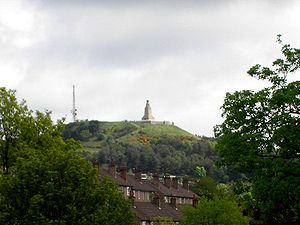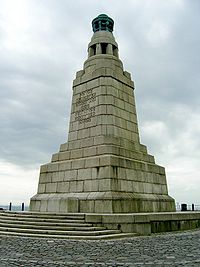
Law, Dundee
Encyclopedia

Dundee
Dundee is the fourth-largest city in Scotland and the 39th most populous settlement in the United Kingdom. It lies within the eastern central Lowlands on the north bank of the Firth of Tay, which feeds into the North Sea...
, Scotland
Scotland
Scotland is a country that is part of the United Kingdom. Occupying the northern third of the island of Great Britain, it shares a border with England to the south and is bounded by the North Sea to the east, the Atlantic Ocean to the north and west, and the North Channel and Irish Sea to the...
. Its predominant feature is an extinct volcano which gives it its name.
Geology
The Dundee Law, which takes its name from the GaelicGoidelic languages
The Goidelic languages or Gaelic languages are one of the two branches of the Insular Celtic languages, the other consisting of the Brythonic languages. Goidelic languages historically formed a dialect continuum stretching from the south of Ireland through the Isle of Man to the north of Scotland...
word for mound or more likely, from Anglo-Saxon hiilāw (modern Scots
Scots language
Scots is the Germanic language variety spoken in Lowland Scotland and parts of Ulster . It is sometimes called Lowland Scots to distinguish it from Scottish Gaelic, the Celtic language variety spoken in most of the western Highlands and in the Hebrides.Since there are no universally accepted...
law) meaning a (grave-)mound, is the plug
Volcanic plug
A volcanic plug, also called a volcanic neck or lava neck, is a volcanic landform created when magma hardens within a vent on an active volcano. When forming, a plug can cause an extreme build-up of pressure if volatile-charged magma is trapped beneath it, and this can sometimes lead to an...
of an extinct volcano
Volcano
2. Bedrock3. Conduit 4. Base5. Sill6. Dike7. Layers of ash emitted by the volcano8. Flank| 9. Layers of lava emitted by the volcano10. Throat11. Parasitic cone12. Lava flow13. Vent14. Crater15...
. Curiously, it is a common mistake for the Law to be referred to as "the Law hill" which is obviously a tautology (much like "Gobi Desert"). Actions by subsequent ice movements further eroded the hill and deposited more debris around the base creating a crag and tail
Crag and tail
A crag is a rocky hill or mountain, generally isolated from other high ground. Crags are formed when a glacier or ice sheet passes over an area that contains a particularly resistant rock formation...
. The shallow gradient of the slopes on the north and eastern sides of the law suggest a north easterly movement of ice flows. The hill's summit is over 500 feet above sea level.
History

Iron Age
The Iron Age is the archaeological period generally occurring after the Bronze Age, marked by the prevalent use of iron. The early period of the age is characterized by the widespread use of iron or steel. The adoption of such material coincided with other changes in society, including differing...
it was the site of a Pictish
Picts
The Picts were a group of Late Iron Age and Early Mediaeval people living in what is now eastern and northern Scotland. There is an association with the distribution of brochs, place names beginning 'Pit-', for instance Pitlochry, and Pictish stones. They are recorded from before the Roman conquest...
settlement. Roman
Roman Empire
The Roman Empire was the post-Republican period of the ancient Roman civilization, characterised by an autocratic form of government and large territorial holdings in Europe and around the Mediterranean....
pottery has been found on the law, suggesting that the Romans may have used it as a lookout post in the first century. The law hill has a tunnel which runs through it. It used to be used for the railways to Newtyle
Newtyle
Newtyle is a village in the west of Angus, Scotland.It lies 11 miles to the north of Dundee in the south west of Strathmore, between Hatton Hill and Newtyle in the Sidlaws. The village sits on gently sloping ground with a northwest aspect. The main communication link is the B954 road...
A war memorial
War memorial
A war memorial is a building, monument, statue or other edifice to celebrate a war or victory, or to commemorate those who died or were injured in war.-Historic usage:...
to the fallen in both world wars was constructed atop the summit. In the years 1992 to 1994 the facilities on the summit of the Law were upgraded by Dundee city district council and Scottish enterprise Tayside with additional funding from the European Commission
European Commission
The European Commission is the executive body of the European Union. The body is responsible for proposing legislation, implementing decisions, upholding the Union's treaties and the general day-to-day running of the Union....
's regional development fund. The memorial is lit with a large flame at its top on a number of significant days, viz: the 25th September (in memory of the Battle of Loos
Battle of Loos
The Battle of Loos was one of the major British offensives mounted on the Western Front in 1915 during World War I. It marked the first time the British used poison gas during the war, and is also famous for the fact that it witnessed the first large-scale use of 'new' or Kitchener's Army...
- in which many members of the local Black Watch
Black Watch
The Black Watch, 3rd Battalion, Royal Regiment of Scotland is an infantry battalion of the Royal Regiment of Scotland. The unit's traditional colours were retired in 2011 in a ceremony led by Queen Elizabeth II....
regiment lost their lives), 24 October (United Nations Day
United Nations Day
In 1947, the United Nations General Assembly declared 24 October, the anniversary of the Charter of the United Nations, as which "shall be devoted to making known to the peoples of the world the aims and achievements of the United Nations and to gaining their support for" its work.In 1971 the...
), 11 November (Armistice Day
Armistice Day
Armistice Day is on 11 November and commemorates the armistice signed between the Allies of World War I and Germany at Compiègne, France, for the cessation of hostilities on the Western Front of World War I, which took effect at eleven o'clock in the morning—the "eleventh hour of the eleventh day...
) and Remembrance Sunday
Remembrance Sunday
In the United Kingdom, 'Remembrance Sunday' is held on the second Sunday in November, which is the Sunday nearest to 11 November Armistice Day. It is the anniversary of the end of hostilities in the First World War at 11 a.m...

